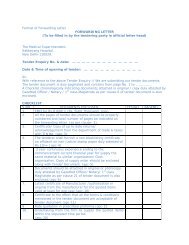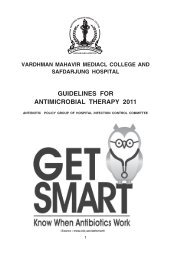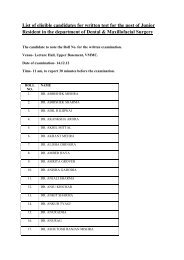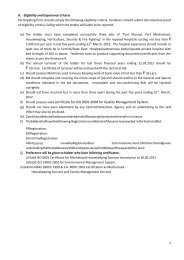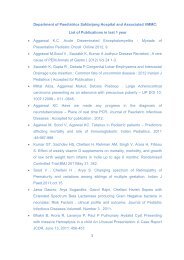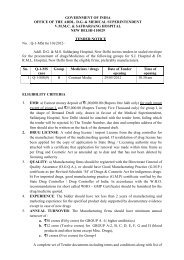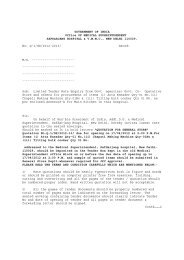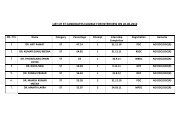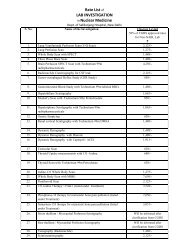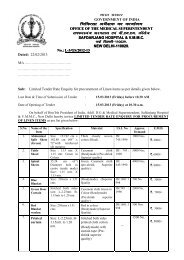Guidelines for INFECTION CONTROL POLICY - Safdarjung Hospital
Guidelines for INFECTION CONTROL POLICY - Safdarjung Hospital
Guidelines for INFECTION CONTROL POLICY - Safdarjung Hospital
You also want an ePaper? Increase the reach of your titles
YUMPU automatically turns print PDFs into web optimized ePapers that Google loves.
8. MONITORING AND SUPERVISIONA Monitoring Team which includes Nodal officers, Nursing Sisters, Technicians and Sanitationstaff is responsible <strong>for</strong> supervision of segregation practices in the specific area, allocated tothem. The Nursing Sister in charge of the area is expected is take a round of the area everydayand record the findings in the observations Daily observation Per<strong>for</strong>ma attached herewith(Annexure II). This Per<strong>for</strong>ma is displayed/available in each clinical area. The DNS of each zoneensure proper compliance of Daily monitoring of waste management practices in the clinicalareas by the ANS/Nursing Sister.The technicians of Laboratories and O Ts will be responsible, <strong>for</strong> the are of their workAny adversity should be reported to are Nodal Officer, who will take appropriate action and ifrequired intimate the same to the higher authorities. The Area Nodal officers will take periodicround of their area, record using ‘Monitoring Per<strong>for</strong>ma’ (Annexure ‘III’) and address any issues.They may also take appropriate action, and in<strong>for</strong>m the respective HODs, and HWM Committee.All the Sanitary Inspectors as well as Health Inspectors will be responsible <strong>for</strong> the wastemanagement practices in the area already allocated to them <strong>for</strong> supervision of sanitation.Regular rounds are taken by CMO, Nodal Officer of HWM. The observation reports of thefindings are sent to the respective HOD <strong>for</strong> remedial action through Medical Superintended.Surprise rounds are also being taken by Addl. MS & MS from time to time in the patient careareas. The random checking of the waste receipts, bags <strong>for</strong> segregation of waste are beingdone at the waste storage site, as a part of audit and any deficiencies / observation are sentto the HOD <strong>for</strong> remedial action.9. FUTURE PROPOSALS :BACK-UP EQUIPMENT FOR TREATMENT OF WASTE:- Backup <strong>for</strong> Microwave and shredder to be procured..- Alternative options of ‘Encapsulation’/outsourcing <strong>for</strong> disposal of metallic sharps, soas to discontinue making any more ‘pits’ or outsourcing <strong>for</strong> disposal of metallicsharps- Autoclave/Hydroclave- Installation of ETP- ‘OUTSOURCING OF WASTE’‘SHARPS INJURY’ (NEEDLE STICK INJURY)A specific protocol <strong>for</strong> prevention of risks of Hepatitis B to HCW of our hospital due to Sharpsinjury (NSI) is being worked out.PATIENT AND ATTENDANT EDUCATION AND AWARENESS :At the time of admission to hospital a briefing regarding the segregation policy of the hospitalshould be given by the Staff nurses and the same is rein<strong>for</strong>ced everyday. Al leaflet of ’Do’s& Don’ts’ will be prepared and given to all attendants of patients at the time of admission.PUBLIC AWARENESS/IEC ACTIVITIES :In order to involve the public and seek co-operation, it is essential to generate awareness byall possible means. This can be achieved through IEC activities. This would help to keep thehospital clean. Public redress system of the hospital can also be used to propagate the samemessage.Posters in the working clinical areas to serve as reminders of segregation protocols will beprepared, and distributed in the whole to be displayed at the prominent points.30



